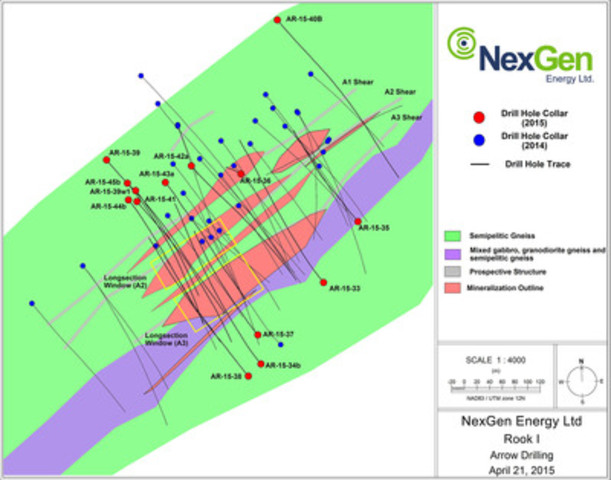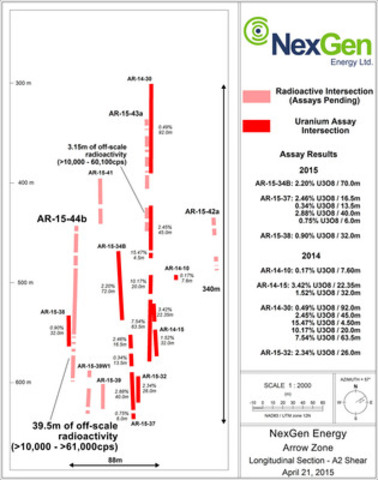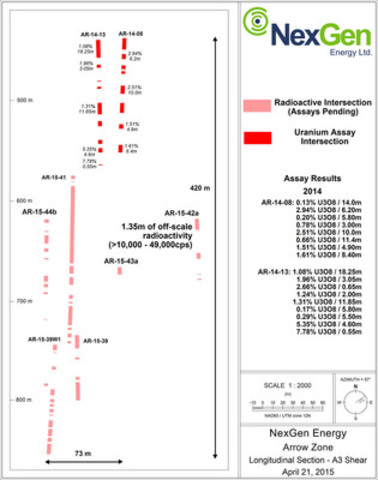NexGen Drills 40.45m Off-Scale within 190.7m of Total Composite
posted on
Apr 23, 2015 09:18AM

Click "edit fast facts" to make changes


VANCOUVER, April 23, 2015 /CNW/ - NexGen Energy Ltd. (TSX-V: NXE) ("NexGen" or the "Company") is pleased to announce ongoing results from our winter 2015 drilling program at our 100% owned Rook I property, Athabasca Basin, Saskatchewan. The reported results are highlighted by angled drill hole AR-15-44b, which has substantially expanded the high grade core of the A2 shear. Angled drill hole AR-15-44b is located 76 m along strike to the southwest from vertical drill hole AR-14-30 (63.5m at 7.54% U3O8, see October 6th, 2014 news release), and has intersected some of the strongest off-scale (>10,000 to >61,000 cps) radioactivity at Arrow to date associated primarily with dense accumulations of semi-massive to massive pitchblende mineralization.
Highlights:
Garrett Ainsworth, NexGen's Vice-President, Exploration and Development, commented "Angled drill hole AR-15-44b has taken the Arrow zone to the next level with almost three times more >61,000 cps total composite off-scale radioactivity than in vertical hole AR-14-30, which is located 76 m along strike to the northeast within the A2 shear. Arrow now has significant off-scale mineralization at both the southwest and northeast extents, which we will aggressively follow up on in our summer drill program. Other mineralized intersections from AR-15-42a and -43a continue to confirm continuity, and increase the extents within the high grade cores of the A2 and A3 shears.
Leigh Curyer, Chief Executive Officer commented, "AR-15-44b is clearly another significant result in expanding Arrow. The drilling methodology of bold step outs keeps delivering outstanding results and the Company is confident of being in a position to deliver an initial resource estimate prior to the end of 2015."
At Arrow, a total of 10,931.4 m has now been reported on from the winter 2015 drill program. Drill hole locations are shown in Figure 1, and long sections illustrating the mineralized pierce points within the A2 and A3 shears at the Arrow zone are shown in Figures 2 and 3, respectively. Drill hole details and scintillometer (handheld RS-120) results are summarized in Table 1.
Table 1: Arrow Zone Drill Hole Data
|
Drill Hole |
Athabasca Group - Basement Unconformity Depth (m) |
Handheld Scintillometer Results (RS-120) |
||||||
|
Hole ID |
Azimuth |
Dip |
Total Depth (m) |
From (m) |
To (m) |
Width (m) |
CPS Range |
|
|
AR-15-44b |
140 |
-75 |
1,011.00 |
108.40 |
430.5 |
433.5 |
3.0 |
<500 - 600 |
|
441.5 |
442.0 |
0.5 |
<500 - 520 |
|||||
|
450.5 |
452.0 |
1.5 |
<500 - 2200 |
|||||
|
455.5 |
461.0 |
5.5 |
<500 - 41000 |
|||||
|
463.5 |
483.0 |
19.5 |
<500 - 35000 |
|||||
|
486.4 |
496.5 |
10.1 |
<500 - 61000 |
|||||
|
499.5 |
568.0 |
68.5 |
<500 - 61000 |
|||||
|
570.5 |
571.5 |
1.0 |
<500 - 1050 |
|||||
|
576.0 |
578.0 |
2.0 |
<500 - 950 |
|||||
|
583.0 |
586.0 |
3.0 |
<500 - 42000 |
|||||
|
590.0 |
613.5 |
23.5 |
<500 - 57000 |
|||||
|
616.0 |
617.0 |
1.0 |
<500 - 7200 |
|||||
|
623.5 |
624.0 |
0.5 |
<500 - 680 |
|||||
|
630.5 |
631.0 |
0.5 |
<500 - 650 |
|||||
|
640.0 |
643.5 |
3.5 |
<500 - 2200 |
|||||
|
652.0 |
653.0 |
1.0 |
<500 - 1700 |
|||||
|
656.5 |
665.0 |
8.5 |
<500 - 2400 |
|||||
|
670.0 |
673.5 |
3.5 |
<500 - 2800 |
|||||
|
680.0 |
684.0 |
4.0 |
<500 - 1100 |
|||||
|
698.5 |
704.5 |
6.0 |
<500 - 4600 |
|||||
|
707.0 |
710.5 |
3.5 |
<500 - 1400 |
|||||
|
715.5 |
717.5 |
2.0 |
<500 - 1800 |
|||||
|
743.6 |
744.0 |
0.4 |
2100 - 12000 |
|||||
|
777.0 |
777.5 |
0.5 |
<500 - 525 |
|||||
|
810.5 |
813.0 |
2.5 |
<500 - 2500 |
|||||
|
827.5 |
828.0 |
0.5 |
<500 - 1900 |
|||||
|
833.0 |
833.5 |
0.5 |
<500 - 1600 |
|||||
|
872.5 |
873.0 |
0.5 |
<500 - 750 |
|||||
|
879.0 |
879.5 |
0.5 |
<500 - 650 |
|||||
|
892.0 |
893.5 |
1.5 |
<500 - 700 |
|||||
|
908.0 |
909.0 |
1.0 |
<500 - 550 |
|||||
|
919.5 |
920.7 |
1.2 |
<500 - 42000 |
|||||
|
934.0 |
941.0 |
7.0 |
<500 - 32000 |
|||||
|
946.5 |
949.5 |
3.0 |
<500 - 1500 |
|||||
|
AR-15-43a |
140 |
-75 |
894.50 |
113.10 |
346.0 |
352.5 |
6.5 |
<500 - 911 |
|
356.0 |
357.0 |
1.0 |
<500 - 550 |
|||||
|
363.5 |
374.5 |
11.0 |
<500 - 1900 |
|||||
|
377.5 |
380.0 |
2.5 |
<500 - 1000 |
|||||
|
385.0 |
395.5 |
10.5 |
<500 - 3000 |
|||||
|
399.5 |
401.0 |
1.5 |
<500 - 1500 |
|||||
|
404.0 |
418.0 |
14.0 |
<500 - 5900 |
|||||
|
437.5 |
449.0 |
11.5 |
<500 - 60100 |
|||||
|
452.5 |
462.0 |
9.5 |
<500 - 2900 |
|||||
|
593.5 |
604.5 |
11.0 |
<500 - 1100 |
|||||
|
657.0 |
657.5 |
0.5 |
<500 - 1500 |
|||||
|
680.5 |
681.0 |
0.5 |
<500 - 600 |
|||||
|
686.0 |
687.5 |
1.5 |
<500 - 1250 |
|||||
|
690.5 |
698.0 |
7.5 |
<500 - 1200 |
|||||
|
714.0 |
714.5 |
0.5 |
<500 - 1350 |
|||||
|
827.5 |
828.0 |
0.5 |
<500 - 700 |
|||||
|
835.0 |
835.5 |
0.5 |
<500 - 1700 |
|||||
|
846.0 |
847.5 |
1.5 |
<500 - 1600 |
|||||
|
AR-15-42a |
140 |
-75 |
819.00 |
108.10 |
142.5 |
144.5 |
2.0 |
<500 - 810 |
|
147.0 |
148.0 |
1.0 |
<500 - 510 |
|||||
|
164.0 |
164.5 |
0.5 |
<500 - 540 |
|||||
|
178.5 |
179.0 |
0.5 |
<500 - 820 |
|||||
|
182.0 |
182.5 |
0.5 |
<500 - 700 |
|||||
|
189.0 |
190.0 |
1.0 |
<500 - 5300 |
|||||
|
240.0 |
241.0 |
1.0 |
<500 - 510 |
|||||
|
279.0 |
284.5 |
5.5 |
<500 - 4600 |
|||||
|
287.0 |
295.0 |
8.0 |
<500 - 750 |
|||||
|
304.5 |
305.0 |
0.5 |
<500 - 550 |
|||||
|
309.0 |
309.5 |
0.5 |
<500 - 510 |
|||||
|
403.5 |
409.5 |
6.0 |
<500 - 1000 |
|||||
|
447.5 |
455.5 |
8.0 |
<500 - 1300 |
|||||
|
459.0 |
466.0 |
7.0 |
<500 - 1700 |
|||||
|
488.5 |
493.5 |
5.0 |
<500 - 1100 |
|||||
|
497.5 |
498.0 |
0.5 |
<500 - 800 |
|||||
|
501.5 |
503.0 |
1.5 |
<500 - 2100 |
|||||
|
644.0 |
655.5 |
11.5 |
<500 - 25000 |
|||||
|
680.5 |
686.5 |
6.0 |
<500 - 10100 |
|||||
|
703.0 |
703.4 |
0.4 |
500 - 28000 |
|||||
|
708.0 |
709.0 |
1.0 |
<500 - 49000 |
|||||
|
734.0 |
735.0 |
1.0 |
<500 - 1800 |
Parameters:
Natural gamma radiation in drill core reported in this news release was measured in counts per second (cps) using a Radiation Solutions Inc. RS-120 gamma-ray scintillometer. The reader is cautioned that total count gamma readings may not be directly or uniformly related to uranium grades of the rock sample measured; they should be used only as a preliminary indication of the presence of radioactive minerals. All intersections are downhole. Core interval measurements and true thicknesses are yet to be determined.
Split core samples will be taken systematically, and intervals will be submitted to SRC Geoanalytical Laboratories (an SCC ISO/IEC 17025: 2005 Accredited Facility) of Saskatoon for analysis. All samples sent to SRC will be analyzed using ICP-MS for trace elements on the partial and total digestions, ICP-OES for major and minor elements on the total digestion, and fusion solution of boron by ICP-OES. Mineralized samples are analyzed for U3O8 by ICP-OES and select samples for gold by fire assay. Assay results will be released when received.
ARROW ZONE DRILLING
AR-15-42a:
Hole AR-15-42a was drilled at an angled orientation (-75° dip) to the southeast (140° azimuth). It was designed to test the A2 shear at a 65 m northeastern step-out from AR-14-30 (7.54% U3O8 over 63.5 m) and the A3 shear at both a 125 m northeastern step-out from AR-15-41 (24.52 m of total composite off-scale radioactivity; assays pending) and a 65 m down-plunge step out from AR-14-24 (1.94% U3O8 over 9.8 m).
The hole intersected bleached and locally heavily desilicified Athabasca Group sandstones between 102.2 m and the unconformity at 108.1 m. Basement lithologies consisted largely of semipelitic gneiss to granofel, and locally pelitic gneiss and mylonite. The hole successfully intersected locally strong mineralization in each of the A1, A2 and A3 shears that was associated with visible disseminated and foliation controlled pitchblende. A total composite mineralization of 68.9 m including 1.35 m of off scale radioactivity (10,000 to 49,000 cps) was intersected within a 592.5 m section (142.5 to 735.0 m) before the hole was terminated at 819.0 m.
AR-15-43a:
Hole AR-15-43a was drilled at an angled orientation (-77° dip) to the southeast (140° azimuth). It was designed to test the thickness of the A2 shear in the vicinity of vertical hole AR-14-30 (7.54% U3O8 over 63.5 m) and the A3 shear at a 50m northeast step-out from AR-15-41 (24.52 m of total composite off-scale radioactivity; assays pending).
The hole intersected pervasively bleached Athabasca Group sandstones between 105.1 m and the unconformity at 113.1 m. Basement lithologies consisted largely of semipelitic gneiss to granofel. The hole successfully intersected locally strong mineralization in the A2 shear and moderately strong mineralization in the A3 shear. Mineralization in the A2 shear was closely associated with semi-massive veins, chemical solution fronts, stringers, blebs and flecks of pitchblende mineralization. A total composite mineralization of 92.0 m including 3.15 m of continuous off-scale radioactivity (>10,000 – 60,100 cps) was intersected within a 501.5 m section (346.0 m to 847.5 m) before the hole was terminated at 894.5 m.
AR-15-44b:
Hole AR-15-44b was drilled at an angled orientation (-75° dip) to the southeast (140° azimuth). It was designed to test the A2 shear at a 45 m up-plunge step-out from AR-15-38 (0.90% U3O8 over 32.0 m) and the A3 shear at a 120 m down-plunge step-out from AR-15-41 (24.52 m of total composite off-scale radioactivity; assays pending).
The hole intersected pervasively bleached Athabasca Group sandstones between 96.4 m and the unconformity at 108.4 m. Basement lithologies consisted largely of semipelitic gneiss to granofel, and relatively narrow intervals of pelitic gneiss and mylonite (the A2 and A3 shears). Extensive uranium mineralization was intersected in the A2 shear that included dense accumulations of massive pitchblende along with semi-massive veins, worm rock-style, chemical solution fronts, stringers, blebs, and flecks of pitchblende and coffinite with rare secondary uranium minerals. Intermittent uranium mineralization was encountered in the A3 shear that consisted of occasional semi-massive veins, disseminations and fracture hosted pitchblende and coffinite. A total composite mineralization of 190.7 m including 40.45 m of off-scale radioactivity (>10,000 cps - >61,000 cps) was intersected within a 519.0 m section (430.5 m to 949.5 m) before the hole was terminated at 1011.0 m. Hole AR-15-44b represents the strongest and most extensive mineralization intersected in any angled hole drilled at the Arrow Zone to date.
About NexGen
NexGen is a British Columbia corporation with a focus on the acquisition, exploration and development of Canadian uranium projects. NexGen has a highly experienced team of exploration professionals with a track record in the discovery of basement and unconformity-style uranium deposits in Canada.
NexGen owns a portfolio of highly prospective uranium exploration assets in the Athabasca Basin, Saskatchewan, Canada, including a 100% interest in Rook I, location of the Arrow Discovery, immediately adjacent to the northeast of the Fission/Alpha JV Patterson Lake South Discovery, and an option to earn a 70% interest in the Radio Project, immediately adjacent to Rio Tinto's Roughrider Deposit.
The technical information in this news release has been prepared in accordance with the Canadian regulatory requirements set out in National Instrument 43-101 and reviewed on behalf of NexGen Energy Ltd., by Garrett Ainsworth, P.Geo., Vice President – Exploration & Development, a qualified person.
Leigh Curyer,
Chief Executive Officer
NexGen Energy Ltd.
+1 604 428 4112
lcuryer@nexgenenergy.ca
www.nexgenenergy.ca
The TSXV has neither approved nor disapproved the contents of this press release. Neither the TSXV nor its Regulation Services Provider (as that term is defined in the policies of the TSXV) accepts responsibility for the adequacy or accuracy of this release.
Forward-Looking Information
This news release contains "forward-looking information" within the meaning of applicable Canadian securities laws. Generally, but not always, forward looking information is identifiable by the use of words such as "will" and planned" and similar expressions. Forward-looking information is based on the then current expectations, beliefs, assumptions, estimates and forecasts about the Company's business and the industry and markets in which it operates. Such information is not a guarantee of future performance and undue reliance should not be placed on forward-looking information. Assumptions and factors underlying the Company's expectations regarding forward-looking information contained herein include, among others: that general business and economic conditions will not change in a material adverse manner; that financing will be available if and when needed on reasonable terms; that the Company's current exploration activities can be achieved and that its other corporate activities will proceed as expected; that third party contractors, equipment and supplies and governmental and other approvals required to conduct the Company's planned exploration activities will be available on reasonable terms and in a timely manner.
Although the assumptions made by the Company in providing forward looking information are considered reasonable by management at the time the forward-looking information is given, there can be no assurance that such assumptions will prove to be accurate. Forward-looking information also involves known and unknown risks and uncertainties and other factors, which may cause actual events or results in future periods to differ materially from any projections of future events or results expressed or implied by such forward-looking information, including, among others: risks related to the availability of financing on commercially reasonable terms and the expected use of the proceeds; changes in the market; potential downturns in economic conditions; industry conditions; actual results of exploration activities being different than anticipated; changes in exploration programs based upon results of exploration; future prices of metal; availability of third party contractors; availability of equipment and supplies; failure of equipment to operate as anticipated; accidents, effects of weather and other natural phenomena and other risks associated with the mineral exploration industry; environmental risks; changes in laws and regulations; community relations; and delays in obtaining governmental or other approvals or financing. There can be no assurance that forward-looking information will prove to be accurate, as actual results and future events could differ materially from those anticipated, estimated or intended. NexGen undertakes no obligation to update or reissue forward-looking information as a result of new information or events except as required by applicable securities laws. The reader is cautioned not to place undue reliance on forward-looking information.
SOURCE NexGen Energy Ltd.


Image with caption: "Figure 1: Arrow Zone Drill Hole Locations (CNW Group/NexGen Energy Ltd.)". Image available at: http://photos.newswire.ca/images/download/20150423_C6858_PHOTO_EN_14663.jpg
Image with caption: "Figure 2: A2 Mineralized Shear Long Section (CNW Group/NexGen Energy Ltd.)". Image available at: http://photos.newswire.ca/images/download/20150423_C6858_PHOTO_EN_14664.jpg
Image with caption: "Figure 3: A3 Mineralized Shear Long Section (CNW Group/NexGen Energy Ltd.)". Image available at: http://photos.newswire.ca/images/download/20150423_C6858_PHOTO_EN_14665.jpg
